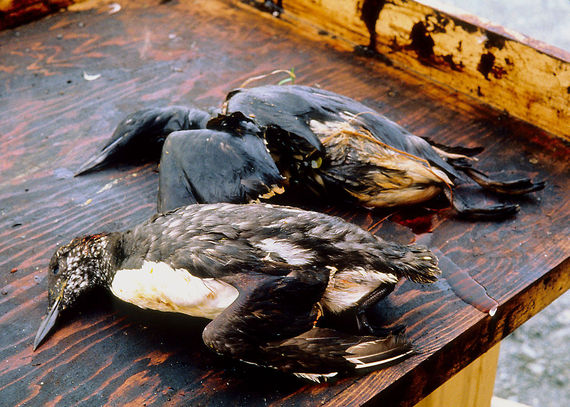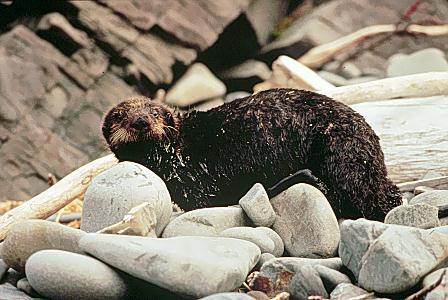Birds killed as a result of oil from the Exxon Valdez spill. (Exxon Valdez Oil Spill Trustee Council)
The Artful Planet series is produced in partnership withthe University of Washington's Conservation Magazine.
Do doom-and-gloom pictures of environmental devastation and catastrophe make green converts?
Birds dead from oil spilled by the Exxon Valdez. An otter soaked in oil from the Exxon Valdez spill resting on the shore. Pictures like this following the notorious oil spill in Prince William Sound alarmed and shocked us -- and they still do today 25 years on. But do these pictures and those like them have any impact on our underlying dependence on petroleum? Or change our feelings about our reliance on fossil fuels?
An otter oiled by the Exxon Valdez oil spill. Do images like this induce us to environmental action? Or the opposite? (Exxon Valdez Oil Spill Trustee Council)
In the Artful Planet column we focus on the role of artists to viscerally connect people to the natural world and thereby inspire them to help steward the planet and assure a more sustainable future for us all. Much of this environmental art is uplifting, portraying the beauty and grandeur of the natural world -- think, for example, of the art of the Hudson River School.
But there is another tradition in environmental art, a darker tradition that features stark pictures of environmental destruction and paints bleak scenarios of a future world of environmental ruin. Much of this -- and what I'm going to focus on today -- is media art: photos, videos, film.
In the case of climate change the examples range from the almost comical doomsday story like the action movie The Day After Tomorrow, which depicts a world run amok by an ice age triggered by global warming, to photojournalism, with moving, sometimes horrific images showing the facts on the ground today, such as photos of cracked, drought-stricken farmland out west, to the new "genre" of dystopian literature referred to as "cli-fi," short for climate fiction.
Such art translates the science into visceral imagery and drama. In fictional art the science can be stretched nearly out of proportion as is the case with The Day After Tomorrow, which takes an extreme possibility -- the shutdown of the ocean circulation triggering an ice age -- to heighten the dramatic effects. Other fictional works, as I have argued is the case with Barbara Kingsolver's Flight Behavior, weaves scientific possibilities (the arrival of monarch butterflies) into a narrative tapestry that brings to life the natural interplay of life on earth. In the case of photojournalism, the visual evidence showing animals choked by pollution, rain forests destroyed by clear-cut logging, or land and vegetation cracked and wilted without water confronts the onlooker with what is going on in a way a dry scientific take cannot. Such art can be quite affecting but does it inspire people to do something about it?
My Own Walk on the Dark Side
Some years ago, when I was chief scientist at the environmental advocacy group Environmental Defense Fund, I had the chance to work on an exciting project. We were partnering with the Ad Council, a nonprofit that creates public service announcements (think McGruff the Crime Dog and Iron Eyes Cody), to produce a series of PSAs for TV and radio to, as the campaign proclaimed, "fight global warming" by building a grassroots public outcry for action on climate change.
We ended up producing four spots, but there was one we were particularly proud of: "The Train."
It opens with a series of shots -- a train track, a close-up of a leaf, another angle of the track, a field -- linked by first the distinct sound of a train whistle then the sound of an approaching train. Cut to a man's face in close-up. "Global warming," he says directly to the camera. Cut to different angles of the fast-moving train. The man continues: "Some say irreversible consequences are 30 years away." More shots of him directly addressing the camera intercut with the oncoming train. "That won't affect me." At this point, the train is right behind him. About to strike him. But seconds before it does, he steps off the train tracks, ever so coolly and calmly. Directly behind him stands a 5- or 6-year-old girl -- who is also looking directly into the camera, silently, as the train is about to obliterate her. But before it can, there is a cut to black. We still hear the train rolling as the words "There's still time ... fight global warming" appear.
It's a hard-hitting ad -- it no doubt got some people's attention and some found it upsetting. (See here and here.) But our purpose in creating the ad was not to upset people, our purpose was to change people -- to wake people up to the potential dangers -- and in so doing change the conversation about climate change.
Looking back, I would have to say we were not successful -- "The Train" and its counterparts did not change the conversation. (A couple of years later a confluence of factors no doubt including An Inconvenient Truth helped affect a change in the conversation, but it was short-lived and by 2009 congressional action on climate had stalled and then even backtracked.)
In retrospect, given the swing in the political pendulum that hit us in the late aughts, it's not clear that any ad campaign could have accomplished significant movement on climate change. Still, I often find myself wondering now if putting all that energy into a gloom-and-doom ad was at all productive. There is a growing body of literature that suggests that it may have even been counterproductive. (For insight on the psychological drivers of this check out this post.) Here's a discussion on one paper in particular.
'Fear Won't Do It'
That's the title of a paper [pdf] by Saffron O'Neill and Sophie Nicholson-Cole of the University of East Anglia in the UK that was published in early 2009 in Science Communication, a quarterly publication "that examines the nature of expertise, the diffusion of knowledge, and the communication of science and technology among professionals and to the public." The authors report on a study where they analyzed people's reactions to images related to climate change. The pictures ranged from starving children and a dried-up lake bed with dead fish (i.e., narrative, fear-inducing) to a cyclist and wind turbine (i.e., more positive, less confrontational).
The results were really startling. While pictures that instill fear tended to get the study participants to see climate change as "important," the images also tended to make them feel disempowered and hopeless. The authors write:
"Fearful representations of climate change appear to be memorable and may initially attract individuals' attention. However, they can also act to distance and disempower individuals in terms of their sense of personal engagement with the issue. These results strongly suggest that the use of fear-inducing or dramatic representations of climate change can be counterproductive when public engagement is a concern... Although shocking, catastrophic, and large-scale representations of the impacts of climate change may well act as an initial hook for people's attention and concern, they clearly do not motivate a sense of personal engagement with the issue and indeed may act to trigger barriers to engagement such as denial.
A more recent study from 2013 conducted by O'Neill et al. found similar results, including the findings that:
► Imagery of the effects of climate change promotes "feelings of salience, but undermines self-efficacy,"
► Imagery of personal mitigative actions and energy futures "promotes self-efficacy," and
► Visuals "appear to either increase saliency, or promote efficacy - but not both."
This last point presents a bit of a quandary. How do you promote feelings of salience and self-efficacy? O'Neil and Nicholson-Cole
"suggest that dramatic representations must be partnered with those that enable a person to establish a sense of connection with the causes and consequences of climate change in a positive manner."
Good idea. But I'd really like to see a study like this that includes artists in the selection and production of the images used. If the object is to find out how to inspire people into action, why not include the experts of inspiration?
Keep up with TheGreenGrok | Find us on Facebook

